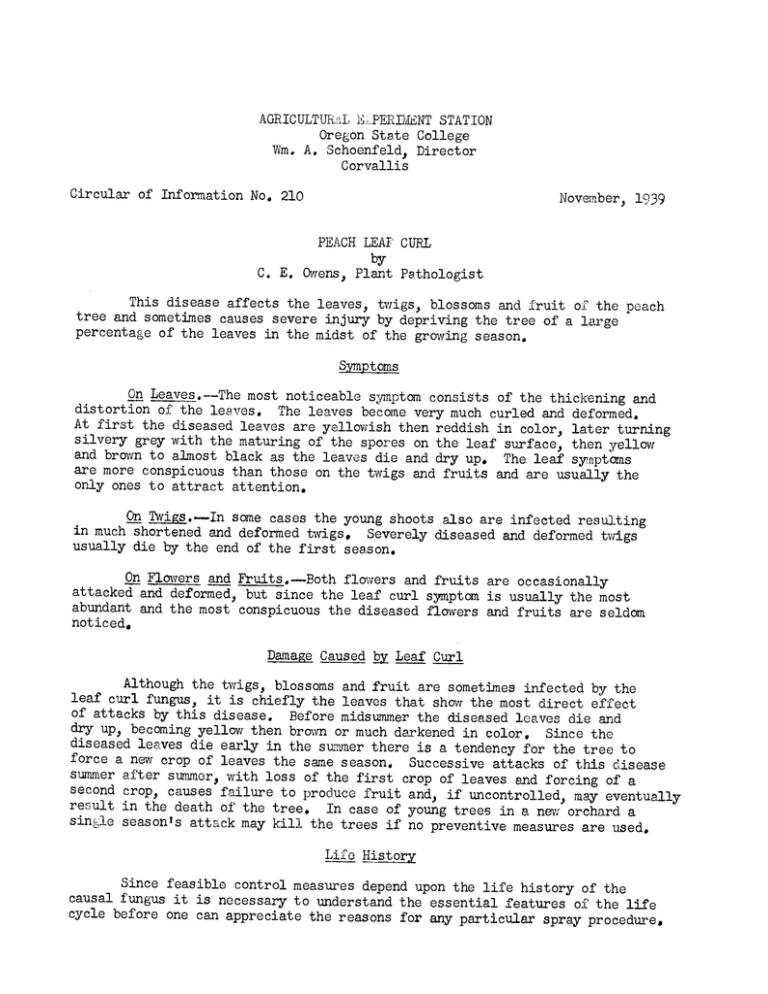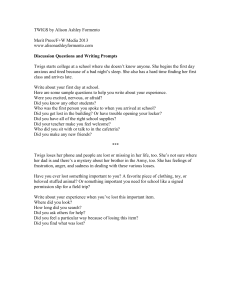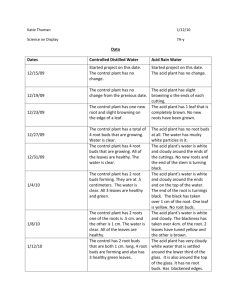AGRICULT1XRL LPERIMtNT STATION Circular of Information No. 210 November, 1939 PEACH LEAF CURL
advertisement

AGRICULT1XRL LPERIMtNT STATION Oregon State College Win. A. Schoenfeld, Director Corvallis Circular of Information No. 210 November, 1939 PEACH LEAF CURL by C. E. Owens, Plant Pathologist This disease affects the leaves, twigs, blossoms and iruit o the peach tree and sometimes causes severe injury by depriving the tree of a large percentage of the leaves in the midst of the growing season. Symptoms On Leaves.--The most noticeable sjrnptom consists of the thickening and distortion of the leaves. The leaves become very much curled and deformed. At first the diseased leaves are yellowish then reddish iii color, later turning silvery grey with the maturing of the spores on the leaf surface, then yellow and brown to almost black as the leaves die and dry up. The leaf symptoms are more conspicuous than those on the twigs and fruits and are usually the only ones to attract attention. On Pwigs.In some cases the young shoots also are infected resulting in much shortened and deformed twigs. Severely diseased and- deformed twigs usually die by the end of the first season. Flowers and Fruits.Both flowers and fruits are occasionally attacked and deformed, but since the leaf curl symptom is usually the most abundant and the most conspicuous the diseased flowers and fruits are seldom noticed. Damage Caused y Leaf Curl Although the twigs, blossoms and fruit are sometimes infected by the leaf curl fungus, it is chiefly the leaves that show the most direct effect of attacks by this disease. Before midsummer the diseased leaves die and dry up, becoming yellow then brown or much darkened in color, Since the diseased leaves die early in the summer there is a tendency for the tree to force a new crop of leaves the same season. Successive attacks of this disease summer after summers with loss of the first crop of leaves and forcing of a second crop, causes failure to produce fruit and, i± uncontrolled, may eventually result in the death of the tree. In case of young tree-s in a new orchard a single season's attack may kill the trees if no preventive measures are used. Life History Since feasible control measures depend upon the life history of the causal fungus it is necessary to understand the essential features of the life cycle before one can appreciate the reasons for any particular spray procedure. 2 The causal fungus produces spores on the surfaces of diseased leaves. These spores are mature at or before niid-suxnmer, The7 are scattered by the winds and presumably lodge on the twigs, especially on the newly forming buds which will produce the leaves and flowers the next spring, Here the spores remain in a dormant condition like particles of dust clinging to the buds and twigs. Early the next spring when the buds begin to swell and burst, exposing the very young ]aves folded in the bud, the hidden spores germinate and infect the young leaves, sometimes before they are out ci' the bud. The fact that the young leaves become infected so early makes it necessary that control measures be applied before the buds swell because after the leaves are infected it is too late to control the disease. control Since the spores are present on the buds all winter and infect the leaves as they begin to emerge from the buds it follows that a killing spray applied to the twigs and buds at any time during the winter before the buds swell will kill the spores clinging on these parts and thus prevent infection. Since in western Oregon the winters are likely to be quite rainy it frequently happens that growers put off spraying for peach leaf curl until toward spring and then find that bad weather prevents their applying the spray until it is too late to get good control. For this reason it is advisable to spray early in the dormant season and thus avoid the danger of waiting too long, The spray program may be summarized as follows: SPRAY PROGRAM FOR PEACH LEAF CURL (1). once with Bordeaux, 6-6-50 after fall and not later than December. tj leaves are (2). Use the best of materials in making up the spray. (3). Do a thorough job. Cover every bud, If at all possible, spray on a clear day so that the (4). spray may dry on the tree before it rains,




